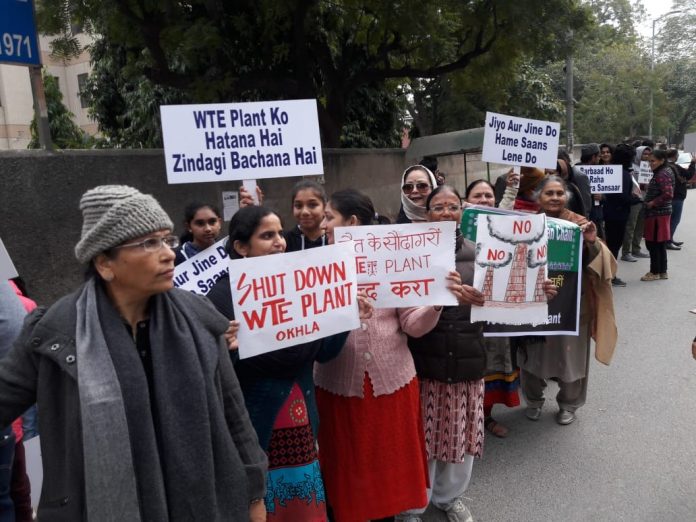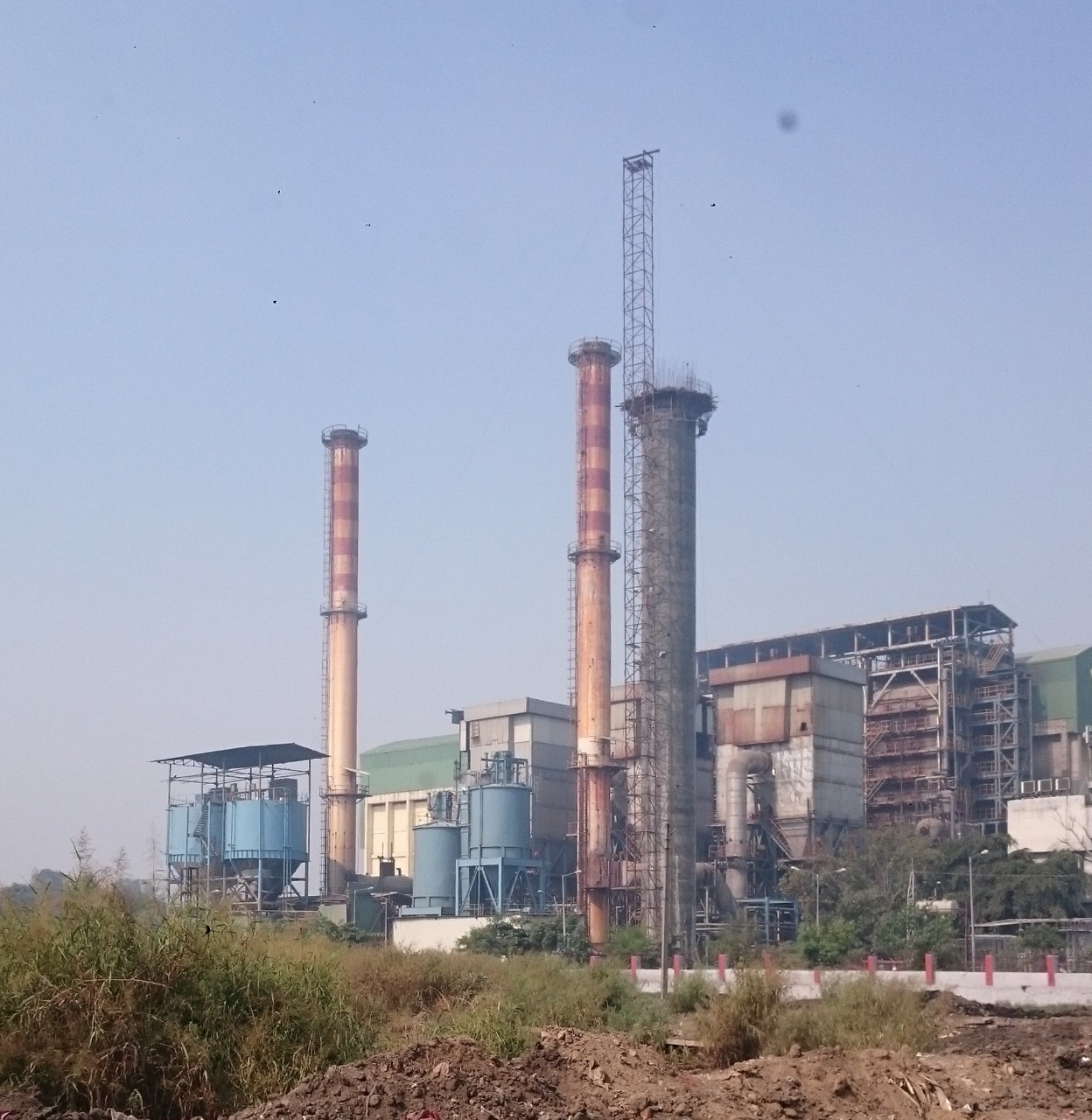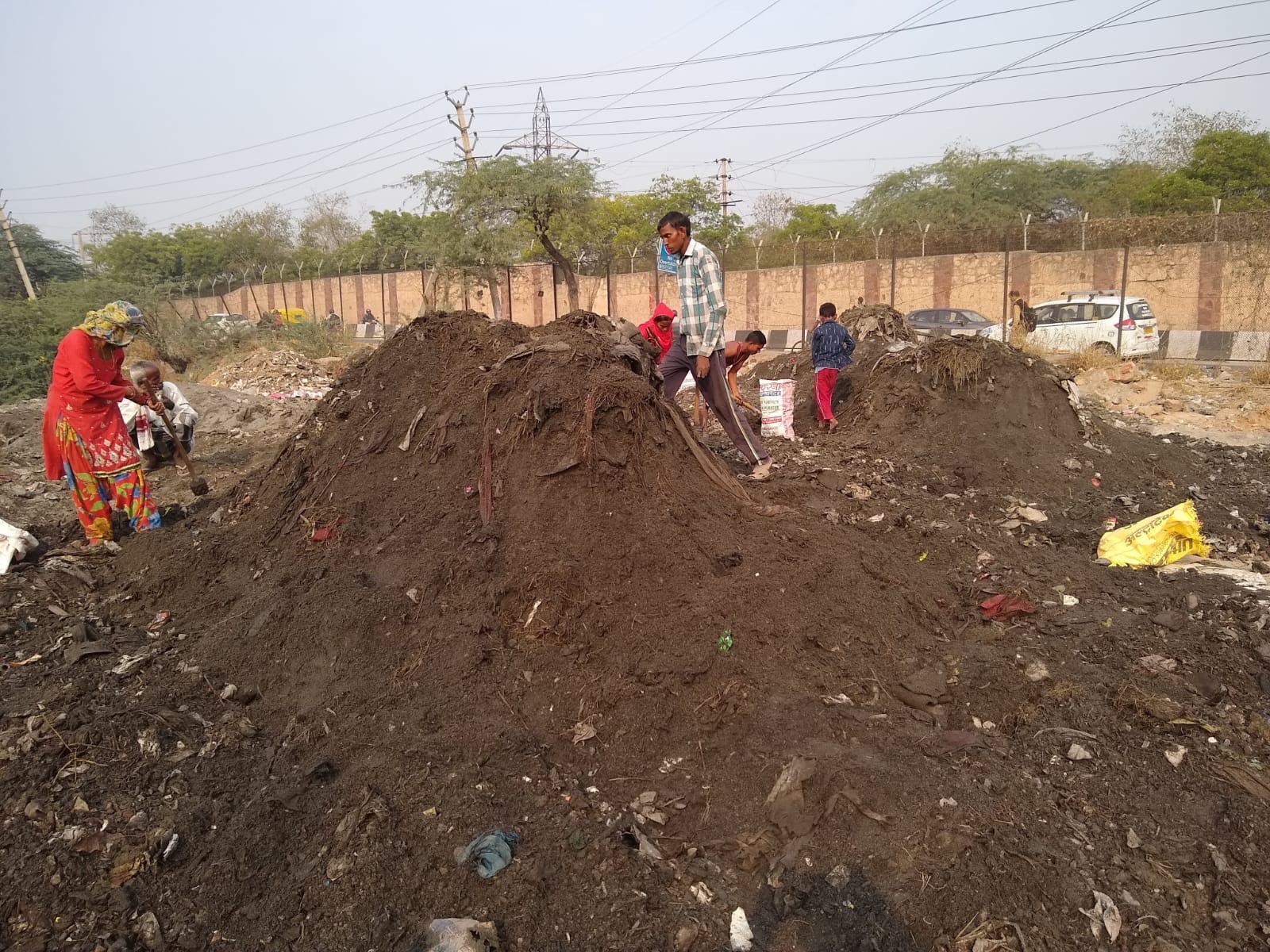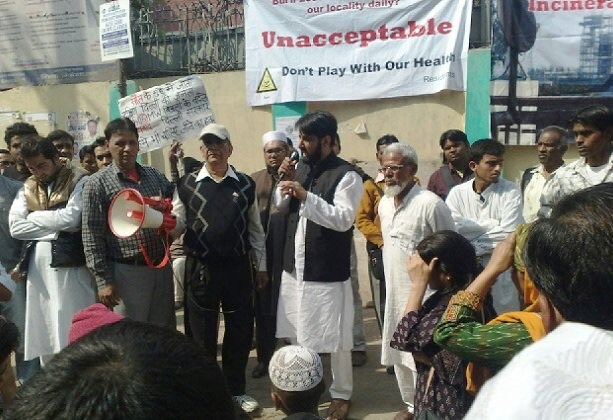
Residents of Oklha in New Delhi are up in arms against a waste-to-energy (WTE) plant in the area which they blame for releasing toxic fumes hazardous to the health of thousands of residents living in the area.
Arbab Ali | TwoCircles.net
NEW DELHI — In early October I met Sumaiya at her two-bedroom rented accommodation in Jamia Nagar’s Haji Colony. The Muslim-majority locality of Jamia Nagar, located at the fringes of New Delhi and the banks of river Yamuna is synonymous with crowded, dingy, and potholed lanes. The 24-year-old law graduate moved to this part of Delhi from Mumbai to pursue law at Jamia Millia Islamia, a century-old Muslim-minority institution.
We climbed to her terrace, from where were visible two flue stacks of the Okhla Waste to Energy (WTE) plant — releasing white smoke while hundreds of vultures circled the skies above the plant.
“Every day white ash settles on my balcony railing,” complained Sumaiya. She coughed a little during our conversation.
Sumaiya’s neighbours in Haji Colony had a similar story to tell. Some complained about the stench while others had difficulty breathing.
The Okhla Waste to Energy (WTE) plant owned by the Jindal group became operational in 2012 after overriding several petitions against it in courts. It is one of Delhi’s three Waste to Energy (WTE) plants — the other two being in Ghazipur and Narela. Delhi, with over 17 million people, generates 11,119 metric tonnes of waste, half of which, approximately 4,900 tonnes, ends up in the three facilities which have an aggregate capacity to process 5,250 tonnes of waste to generate 52 megawatts (MW) of power every day.

Some 1000 meters north of Sumaiya’s home, on the opposite end of the Okhla plant, in the posh locality of Sukhdev Vihar, I met A, a man in his late fifties who moved to this side of the city almost three decades ago when the Delhi Development Authority (DDA) began constructing flats in the area. A, like several other residents of the area, has been up in arms against the plant. He spoke to me on the condition of anonymity fearing reprisal from the Jindal group. “I’ve been threatened several times by the Jindal corporation. Three years back they took my picture and floated it around,” he told me.
A said that there are reasons to believe that the WTE plant emits Dioxins and Furans from the flue gas (the gas exiting to the atmosphere via a flue/stack). Dioxins and Furans are considered to be among the most toxic substances known and identified as being war chemicals.

A told me about a gynaecologist in Sudkhev Vihar who suggests her pregnant patients shift to other areas of Delhi because of the harmful effects of the pollution from the Okhla plant on the fetus. I tried reaching out to this gynaecologist. This story will be updated when she responds.
In early November 2019, the residents’ welfare association (RWA) of Sukhdev Vihar also wrote to the secretary of the Ministry of Health and Family Welfare that no testing was being carried out for Dioxins and Furans.
Fear of boiler explosions
At 45 meters, Sukhdev Vihar and Haji Colony are highly vulnerable in case of a boiler explosion. Falling within the boiler explosion impact zone are the women’s hostels of the Jamia Millia Islamia (with a capacity of 1,200 students) and residences for staff and students of Central Road Research Institute (CRRI) and the CSIR Institute of Genomics and Integrative Biology.
The ETW plant is also in the vicinity of five private hospitals—the high-end Escorts-Fortis Heart Cares Institute and Indraprastha Apollo, Holy Family and Al-Shifa hospitals, and the smallest of the five, Cribs Hospital. A 336-bed government hospital in Okhla’s Sarita Vihar with construction 60% complete is also just 4.5 kilometres away.
The boundary of Okhla Bird Sanctuary is about 2 kilometres from the Waste to Energy Plant. In an affidavit before the National Green Tribunal in 2013, the UP government had said that their inspection had found that the plant lies 2 kilometres from the sanctuary and action could be taken for this violation. The plant never took the approval of the National Board for Wildlife, A told me. The National Board for Wildlife is the apex body in India for all wildlife-related matters.
The catchment area of the stack of the plant covers a population of nearly 1 million people in the adjacent colonies of Muslim-majority Jamia Nagar, including Haji Colony, Ghaffar Manzil, Batla House, Zakir Nagar and Abul Fazal Enclave.
It was no surprise that the local residents allege communal bias in Deciding the location of the plant. “It could have been placed anywhere else in Delhi. But, they decided to place it in Okhla,” remarked a resident of Ghaffar Manzil.
“What happens if a boiler explosion occurs tomorrow? Where are we supposed to run,” asked Vinayak Malik, secretary of Pocket B Sukhdev Vihar Residents Welfare Association (RWA)
“This is a powder keg,” he added.
Deviation from approved technology
The pollution hazards posed by the plant from proximity to residential areas are compounded by drastic deviation from the approved technology – the waste is fed directly to incineration in boilers and generation of power as noted by the National Green Tribunal in an order from January 2017.
The plant is not near a landfill as required under Municipal solid waste (MSW) handling rules. “There is a movement of hazardous ash and residues along an eight-kilometre stretch of Mathura Road (NH2),” said Shahrullah Khan, a man in his early sixties and the general secretary of Pocket A Sukhdev Vihar Residents Welfare Association (RWA).
The residents say that there is a new waste-to-energy plant at Tehkhand near a landfill and is the proper place for a massive incinerator of this type. “Shift it there. We don’t want it near our homes,” a resident of Haji Colony told me. She didn’t wish to be named.
The manual on Municipal solid waste (MSW) handling, released under Swachh Bharat by the Ministry of Housing and Urban Development, stipulates that waste-to-energy plants be located no closer than 300 meters from residences and in zones meant for medium or heavy industry. “This plant stands on a Green Belt under Delhi Master Plan 2021 and is not covered by ‘change in land use as required by the DDA Act. The question is how did the DDA allow this polluting plant next to its colony,” he added.
Plant gets green light for expansion
A National Green Tribunal (NGT) order on October 12 allowed for the expansion of three Waste to Energy (WTE) plants in the capital to proceed without environmental clearance.
During a public hearing on the expansion proposal organized by Delhi Pollution Control Committee in August this year, the affected residents opposed the move, citing the violation of pollution norms by the plant.

The Jindal Group has repeatedly maintained that the WTE plant posed no harm to the public. During the public hearing, Vikramjeet Singh of the Jindal Group was quoted by the Times of India, saying, “The distance of the boiler from the residential areas is 210 metres. The plant is not harming anyone and the emissions are under control. Residents claim that they are getting lung diseases. That’s not because of the plant, but due to Covid. Otherwise, how are our workers healthy and fit?” He insisted that the diseases “existed in the area before the installation of the power plant.”
Fined multiple times for violation of pollution norms
The Okhla Waste to Energy (WTE) plant has been fined multiple times in the past for violation of air pollution norms. In 2017, the National Green Tribunal slapped Rs 25 lakh fine on the Okhla plant for affecting the environment. Four years later, in August 2021, the Okhla plant was again fined, this time, Rs 5 lakh by the Delhi Pollution Control Committee when several parameters, including dioxin and furan emission values, were found to be around 10 times the permissible limit.
A trail of protests by people and violations of laws by the plant
There have been over a dozen protests by the thousands of residents of Jamia Nagar and Sukhdev Vihar. A recalled how people attended the protest, some of which also attended by Amanatullah Khan, the local MLA from the Aam Aadmi Party. He and others alleged that while Amanatullah Khan made a career out of politics on the Okhla plant, he maintained to not speak on the issue now that he has established himself in politics. Amanatullah Khan did not respond to the mail sent to him.
Shaharullah Khan, a man in his early sixties and the general secretary of Pocket A Sukhdev Vihar Residents Welfare Association (RWA) said that the plant was burning waste that has “half the calorific value of genuine Refuse Derived Fuel (RDF).”

Only slightly over half of the municipal solid waste (MSW) in Delhi is biodegradable and its calorific value does not exceed 1,324 kcal/kilograms when self-sustaining combustion requires it to be 1,800 kcal/kg.
According to a 2019 report by the Center for Science and Environment, a Delhi-based non-profit, only about 13 per cent or 1,100 to 1,300 tonnes per day (TPD) — of Delhi’s then total waste of 10,500 metric tonnes of waste is ideal as waste feed for the Waste to Energy (WTE) plants.
“In India, everything is low quality, even our rubbish,” A funnily remarked.
The residents of the Sukhdev Vihar area met officials of the Ministry of Environment, Forest and Climate Change (MoEF) in October and November of 2018 and alleged that the Okhla plant was not complying with the environmental pollution standards and was not in line with the original proposal as envisaged in the Environmental Impact Assessment Report (EIAR), a report of the effects which any proposed project if carried out, would have on the environment and expansion activities were being taken place by the company.
On 20 November, of that same year, the ministry constituted a committee for conducting a site visit to the Okhla plant. A month later, on 15 December the committee visited the plant and submitted its report to the ministry.
In January 2019 the corporation submitted an online application to the ministry for an amendment of environmental clearance for power generation capacity from the existing 16 MW to 23 MW, without increasing the waste feed to the boilers as per the environmental clearances issued back in 2007.
The ministry took notice of the increase in waste throughput to the incinerators leading to in the pollution load, increase in power generation, the construction of a new chimney without prior permission, and failure to set up the bio-methanation plant as non-compliances with the environmental clearance and sent show cause notice to the corporation on 16 April 2019.
Vinayak Malik, secretary of Pocket B Sukhdev Vihar Residents Welfare Association (RWA), told me that the company installed three boilers each with a capacity of 450 mega tonnes per day. The power generation capacity was increased from 16 megawatts to 20 megawatts, resulting in higher emissions and the total unsegregated waste handling at the plant was increased to 2000 tonnes per day. A new stack was also constructed at the site without approval.
According to the environmental clearance, only one boiler (incinerator) was allowed with a capacity of 750 mega tonnes per day while the approved quantity of waste handling was 1525 tonnes per day.
The company claimed that they had augmented equipment such as storage, pre-segregation/processing facility, grate incinerators, steam flow, and heating equipment, air-cooled condenser system, turbine and generator, construction of chimneys, air pollution control equipment, leachate treatment systems to meet the additional MSW load.
The director of the Impact Assessment division of the Ministry of Environment, Forest & Climate Change, S. Kerketta noted in a letter that the ecological damage assessment and remediation plan for increasing the quantity of waste incineration to 1500 tonnes per day as against the approved quantity of 750 tonnes per day under environmental clearance, would be undertaken by the Central Pollution Control Board (CPCB), a government organization responsible for air and water quality monitoring in the country. It was further noted that the company would have to deposit the compensation decided in the remediation plan with the Central Pollution Control Board, which would be used for the restoration of natural resources affected by the plant.
“The Ministry also said that the Dioxins and Furans from the flue gas (the gas exiting to the atmosphere via a flue/stack), would be monitored once a month and the emission data to be submitted to the Ministry, Central Pollution Control Board, Delhi Pollution Control Committee and Ministry’s regional office including uploading it on the company’s website,” said Malik.
Malik told me that the emission monitoring carried out by the Central Pollution Control Board has shown certain deviations in the particulate matter and heavy metal compounds. “However, due to technical problems, the pollution control board was not able to monitor Dioxins and Furans,” he added.
Arbab Ali is a fellow at the SEEDS-TCN mentorship program.

